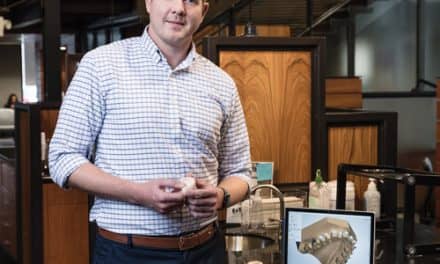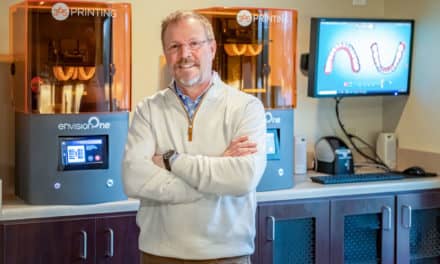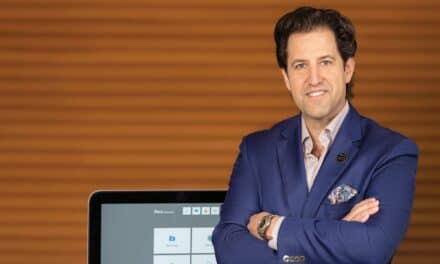By Lori Sichtermann | Photography by Dwight Cendrowski
Not everyone gets to sit on the other side of retirement and reflect on a successful career. Lysle E. Johnston, Jr, DDS, MS, PhD, FDS, RCS(E)—now quasi-retired after more than 5 decades in the specialty—can reflect on the distinguishable and distinguished mark he has left on orthodontics, while continuing to shape the future of the profession.
Johnston’s journey in orthodontics started when he graduated from the University of Michigan School of Dentistry in 1961 and from Michigan’s Horace H. Rackham School of Graduate Studies (Orthodontics) in 1964. After studying anatomy at the Queen’s University of Belfast, he went on to earn a PhD in Anatomy from Case Western Reserve University in 1970. He then chaired the orthodontic departments of Case Western Reserve University (from 1971 to 1976) and St Louis University (from 1976 to 1991).
At Michigan, he chaired the Department of Orthodontics and Pediatric Dentistry and was the Robert Browne Professor of Dentistry from 1991 to 2004. He also served as director of the Graduate Orthodontic Program.

“I’m an autodidact. I’m kind of self-taught in the things I teach,” Johnston notes with humility. “I tended to teach the things that I thought were important, yet no one else wanted to teach. Thus, I have a collection of relatively unpopular courses. They’re good courses, though.”
Regardless of whether he considers his course titles undesirable, Johnston has never had difficulty filling seats. For more than 50 years, he has perfected his delivery method, favoring abstract thought over point-and-spout lectures. “There’s a real market for straight teeth, but not for straight thought,” he says. His quick wit and aggressive nature toward critical thinking have made him one of the most popular professors in the specialty.
As a career-long academic in the field of orthodontics, Johnston has seen the tides of fashion toward specific techniques change numerous times. As he continues teaching and staying abreast of current research and trends in the field, Johnston admits that some things about the future of the specialty excite him, while others seem disagreeable.
“The Hot Ticket”
Johnston’s entrance into the orthodontic specialty was a bit serendipitous. And like many things in his life, it has a hint of humor to it. “I grew up in far northern Michigan in a town of about two thousand. We didn’t have any resident ?orthodontists, so a doctor from a larger town would come up in the summers and treat anything that could be handled in about 3 months,” Johnston explains. “I had a couple second molars and crossbites to remedy. The orthodontist put on two bands and a piece of elastic. He charged my father $100 dollars. Back in 1949, I thought, ‘Wow! That didn’t seem too difficult, and that was a lot of money.’ So, to a 12-year-old, orthodontics seemed like the hot ticket. It’s as simple as that.”
As the years went on, his motivation may have changed dramatically, but he still retained the idea of being an orthodontist based on the idealized view he had of the profession as a child.
“Coming from a small town in northern Michigan, I always thought that I would get my education in orthodontics and practice in Traverse City, the largest town in my area,” Johnston explains. “Instead, by the time I graduated from dental school, a guy from Minnesota already moved into the area, and I was repeatedly told that the entire northern half of Michigan could not support another orthodontist.”
Believing northern Michigan could not support more than one orthodontist, Johnston decided to change course from his original plan. “Being a small-town boy, I couldn’t think of where else I could have practiced. So, I took the path of least resistance and went on with my studies,” he says. “I went to Ireland and studied anatomy and came back and got a PhD in neuroanatomy at Case Western Reserve. I thought these would be more interesting than practicing orthodontics in a small town elsewhere.”
“Being an Academic Orthodontist Is Dangerous”
Having decided that private practice wasn’t in the proverbial cards, Johnston entered into academia. Throughout the next 50 years, he would spend his time in the halls of thought, studying the differential effects of various orthodontic treatments, the mechanisms of facial growth, and the nature of the interaction between growth and treatment.

During the course of his academic career, Johnston became a trusted and sought-after mentor to his students. To date, he’s advised approximately 100 master’s theses, a quarter of which have won AAO research prizes. What’s more, Johnston has contributed to the education of nearly 500 orthodontic specialists practicing today.
After all of his accomplishments in the field, Johnston is still humble about his half-century of work. “Being an academic orthodontist is actually kind of dangerous,” he notes. “When you’re in practice, no one fires you or denies you tenure. I figure myself very lucky to have gone through an academic career and quietly retired.”
For Johnston, however, “retirement” has been a relative term. He left full-time academia in 2004, but continues to teach, influence, and argue for the specialty.
“We’ll Find Out …”
It goes without saying that the world is a different place than it was 50 years ago. So it’s no surprise that Johnston, during his half-century tenure in the specialty, has witnessed enormous change in the profession since he graduated from dental school.
“When I graduated, plain-out mechanics were the most important issues. What was the best way to move teeth? We were very interested in the prevention of malocclusions. We thought that we could get rid of habits to prevent malocclusions from happening. We were very concerned about stability and cranial facial biology,” Johnston explains. “All of the issues listed above are no longer of significance.”
Instead, Johnston sees topics such as the popularity of a treatment with referral sources and a fear of litigation as major factors in the profession today. “It’s very different than it was 50 years ago,” he adds.
When asked about those who offered him the best career advice throughout his decades in orthodontic academia, he makes light of the question: “I was almost thrown out of dental school several times—one time I was blameless, two other times I was not blameless—so advice from those deans doesn’t count.” He then goes on to cite a handful of former professors and colleagues who had a lasting impression on him.
As a current educator, Johnston has maintained a passionate understanding of the advancements made in procedures and technologies. To say that he has been in agreement with all of them would be a blatant misrepresentation. In fact, Johnston has been known to argue the use of technology and procedural change on more than one occasion.
Issues such as the debate over one-phase versus two-phase treatment strike him as essentially contrived, never-ending controversies that merely serve to mask the truth that is available to anyone who researches the subject objectively.
“With regard to some ideas that are popular today, we’ll find out whether expansion rather than extraction is a good idea,” Johnston predicts. “We’ll find out whether we can grow bones, and choose the correct course of appliances. Maybe we’ll even realize the goodness or badness of lifetime retention. The sure thing is that the future holds a lot of potential for the specialty.”
Johnston has some highly charged forecasts for technological advancements that have been made in the profession as well. “There are a lot of highly computerized technical services that will probably find their natural level: prefabricated aligners, robotic wire bending, cone beam CTs,” he notes. “In my opinion, cone beam CTs, right now, are an answer in search of a question. Presumably, all of these things will find their natural level within the specialty.”
Although practice methods and the relevance of certain types of technology are always on the discussion table for Johnston, it’s the topic of the well-rounded orthodontist that truly provides cause for debate, as far as Johnston is concerned. Looking ahead to the decades to come, Johnston is concerned about the profession’s ability to produce academic orthodontists, a necessary element to the specialty.
“The one big thing this specialty has to realize is that there really is a difference between a teacher and an academic,” Johnston asserts. “The specialty needs academics whose business it is to husband ideas, as opposed to applaud the crazy stuff. That’s going to be a problem in the future. There are lots of new programs and dental schools starting up, yet the number of committed academics is going down. That’s going to create a big impact on the status of the specialty in everybody’s mind.”
“A Learned Calling”

“As stated previously, I’m an autodidact. I’m kind of self-taught in the things I teach,” he explains. “I was a chairman for 34 years, and I tended to teach the things that I thought were important, yet no one else wanted to teach.”
Johnston uses his autodidactic tendencies as an example to explain his concern with the academic side of orthodontics. During his career, he’s had a number of renowned confrontations with some in the specialty, with the general nature of these disagreements rooted in the progression of thought in orthodontics.
“The one thing they had in common was that, in my opinion, their ideas were dangerous to orthodontics’ status as a learned calling,” Johnston explains. “I thought they were dangerous to the soul of the specialty.”
Intellectually speaking, Johnston feels that orthodontics has fallen behind other specialties. “When I went in, there used to be a moment when the Chair would bring all of the new students into the conference room and we would be welcomed into a thinking man’s specialty,” he notes. “Now that’s not too much of a concern, judging from the fact that it is very difficult for an orthodontist to get financial support for orthodontic research. Other fields get support, but it’s difficult for orthodontists.”
As a result, Johnston believes orthodontics is feeding a little bit further down the trough than it used to. “In general, the specialty is not interested in the work product of an academic, which is, dare I say, ‘research,’ ” he adds. “Teaching is one of the things an academician does; however, teaching grows out of—and is nourished by—one’s research. In general, people don’t go into academics to teach.”
Much like the misguided advice given to Johnston when he was a young dental school graduate—that one orthodontist was all that the northern half of Michigan needed—the common thought in the orthodontic profession today is that academics is not sustainable as a career option.
“It’s difficult to get people to contemplate an academic career now,” Johnston notes. “The smart young residences perceive that this is not really a market for true academics, which is the creation and husbanding of ideas. If they perceive that there is not a great market for that, who’s going to go into something for which there is no market?”
When it comes to the private practice side of things, Johnston is enthusiastic about much of what the future holds. “It’s a popular, respected, and well-paid calling, a highly valued service that does wonderful things for children,” he says. “For the practitioner, it’s hard work, but it’s pleasant hard work.”
Reviewing his own career, Johnston can only relay—and in some ways, lament—what he has come to know firsthand. “In my particular version, I’ve met and interacted with an incredible variety of really interesting people,” he explains. “And, by interacting, in many cases, it was fighting with them—intellectual disagreements. Sometimes, these disagreements were quite heated. Over the last quarter century, I’ve been threatened with lawsuits, several times, just for disagreeing with people. By interacting with a variety of people, I’ve seen a lot of the world. And, I’ve helped to educate hundreds of orthodontic residents. I’ve interacted with a goodly percentage of today’s practicing orthodontists, and that’s a great position to have had.”
Lori Sichtermann is a contributing writer for Orthodontic Products.
The Legend of the Rubber Chicken

Lysle personally interviewed all of the applicants for all three orthodontic programs throughout his tenures. Every interviewee has a story to tell about that intimidating experience. Some were accepted on the spot, and others may have kicked a dent in their car. Lysle always asked applicants, “Why do you want to be an orthodontist?”
The mundane and unimaginative responses became routine. On his birthday (October 23, 1984), Lysle wrote one of these common responses (“I like to work with children”) on a slip of paper and placed it into the bill of a rubber chicken that someone had given him as a birthday present. Lysle asked the next residency candidate the $64,000 question and, sure enough, his answer matched the “secret words.” Just as it might have happened on Groucho Marx’s “You Bet Your Life” television program, Lysle brought the rubber chicken out and said, “My friend has a message for you.” Unfortunately, the paper fell out and Lysle just picked it up.
Before he exited the interview, the interviewee, a rightfully apoplectic Rich Joseph, pleaded, “I gotta know! What was on the paper?” Lysle just gave him the missive without explanation. With all the color gone from his face, the shaken applicant asked the first resident he found, “What does it mean? I got the rubber chicken.” I told him, “I don’t know, but it doesn’t sound good.” Actually, Rich was accepted!
Although interviews with Johnston were already legendary, the mythology of the plastic poultry grew. Rumors spread that the chicken made regular appearances during interviews or that Lysle would hit people with the chicken when they were not accepted. He started to receive rubber chickens as gifts. Students made T-shirts featuring the rubber chicken and the phrase, “I like to work with my hands.”
Rich Joseph got the last laugh. A couple of years later, the residents were attending the Moyer’s Symposium in Ann Arbor. At the reception, Rich came up to a table of influential orthodontists where Lysle was holding court in a heated discussion. He had slipped in some convincing “Billy-Bob” teeth that he had made and proclaimed, “Hey, Dr Johnston! Do you remember me? I was one of your patients, and I really love my smile!”
The rubber chicken is now retired and resides in a special place at Johnston’s Fortress of Solitude in northern Michigan. Lysle even had an art-glass window of a rubber chicken created for his home. Although the students he has influenced and taught critical thinking will remember their own Johnstonisms, the rubber chicken will likely be an enduring legacy that will always be associated with Lysle Elwin Johnston, Jr.
—S. Jay Bowman, DMD, MSD
Words of Wisdom
“In 1982, Dr J accepted me into the orthodontic program at St Louis University. I will be forever grateful to him for allowing me admission to this specialty. When I left dental school I had been taught to challenge nothing and believe everything I was told, sort of like a Democrat. Dr J taught me to think critically and to challenge everything. It was important to peel away the layers and validate claims. This has served me well over the years, not just in orthodontics, but in life as well. Skepticism can keep you out of trouble!”
—Kevin C. Walde, DDS, MS
“This was back in the early 1980s at the height of the functional appliances fashion. When Lysle Johnston saw the Wasilly chairs in my living room, he said he was afraid to sit in one. He thought it looked like a giant Frankel appliance and if he sat in it, his bottom might get wider and rounder.” —Orhan C. Tuncay, DMD
In closing, Bruce Scarola, DMD, MSD, offers his favorite Johnston quotes:
“My time means nothing, and yours means even less.”
“One dishonest claim can create enough work to keep an honest researcher busy for years.”
“In 2 years, we’ll all be 2 years closer to the grave. The weather in St Louis is not that great, so don’t plan on seeing much of it. You are here to learn orthodontics.”
“If orthodontics is an art and a science, then you better be a hell of a scientist, Doc.”






